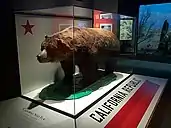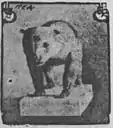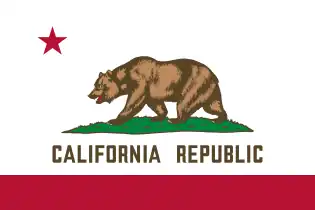California grizzly bear
The California grizzly bear (Ursus arctos horribilis, formerly Ursus arctos californicus) is an extinct population of the brown bear,[2] generally known (together with other North American brown bear populations) as the grizzly bear. "Grizzly" could have meant "grizzled" – that is, with golden and grey tips of the hair – or "fear-inspiring" (as a phonetic spelling of "grisly").[3] Nonetheless, after careful study, naturalist George Ord formally classified it in 1815 – not for its hair, but for its character – as Ursus horribilis ("terrifying bear").[4] Genetically, North American brown bears are closely related;[5] in size and coloring, the California grizzly bear was much like the Kodiak bear of the southern coast of Alaska. The grizzly became a symbol of the Bear Flag Republic, a moniker that was attached to the short-lived attempt by a group of U.S. settlers to break away from Mexico in 1846. Later, this rebel flag became the basis for the state flag of California, and then California was known as the "Bear State".[6]
| California grizzly bear | |
|---|---|
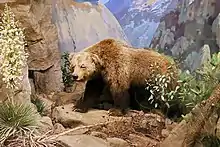 | |
| Specimen at the Santa Barbara Museum of Natural History | |
| Scientific classification | |
| Domain: | Eukaryota |
| Kingdom: | Animalia |
| Phylum: | Chordata |
| Class: | Mammalia |
| Order: | Carnivora |
| Family: | Ursidae |
| Genus: | Ursus |
| Species: | U. arctos |
| Subspecies: | U. a. horribilis |
| Population: | †California grizzly bear |
| Synonyms | |
| |
Taxonomy
A 1953 researcher stated, "The specific status of North American brown bears (or grizzly bears) is one of the most complex problems of mammalian taxonomy. The difficulty stems directly from the work of Merriam (1918), who concluded that there are 86 forms of grizzlies (and brown bears) in North America."[7]
North American brown bears were taxonomically grouped as a species apart from other bear species, until DNA testing revealed that they should properly be grouped in the same species as the other brown bears.[5] Grizzlies living in California had been classified by Merriam into many subspecies, but the only genetically anomalous grouping in North America is the ABC Islands bears.[8]
Appearance
The California grizzly was an enormous bear. Father Pedro Font, an early missionary, described the local grizzly bears, writing, "He was horrible, fierce, large, and fat."[9] In the 1800s, multiple newspaper accounts mentioned bears weighing well over 1,000 pounds (450 kg) . The hind foot of one particular adult male grizzly was measured at 12 inches (300 mm) long by 8 inches (200 mm) wide, and claws were often 2 inches (51 mm) wide by 3.5 inches (89 mm) long.[10] The average bear was 8 feet (244 cm) tall, or about 4.5 feet (137 cm) at the shoulder. Furthermore, they could reach speeds of up to 35 mph (56 km) over short distances.[11]
Distribution and habitat
Prior to Spanish settlement in the second half of the 1700s, it is estimated that 10,000 grizzly bears inhabited what is modern-day California.[12] It is thought that the bears lived across almost the entirety of the state, save its most southeastern and northeastern corners. Probably the southernmost records for this subspecies are from the Sierra de Juárez, during the 18th century. The bears ate a diverse diet from California's varied climates, ranging from plant sources like grasses, seeds, and berries, and acorns, to animal sources such as deer, salmon, steelhead, and carrion – including beached whale carcasses.[13][14][9]
Relationship with humans
European contact
The first documented sighting of a grizzly bear in California occurred in 1603 when a Spanish explorer near Monterey described how bears came down to feed on a whale carcass stranded on the beach. However, his reports weren’t widely circulated so the existence of grizzlies in California wasn’t well known until the eighteenth century.[15]
Europeans' first well circulated encounters with California grizzly bears are found in diaries kept by several members of the 1769 Portola expedition, the first European land exploration of what is now the state of California. Several place names that include the Spanish word for bear (oso) trace their origins back to that first overland expedition (e.g. Los Osos). As the settled frontier of New Spain was extended northward, settlers began to populate California and establish large cattle herds as the main industry. The ranchers' domesticated livestock were easy prey for the grizzly bears roaming freely across the state. In turn, grizzly populations increased around human settlements.[16] By eating their livelihood and scaring them, the grizzlies became enemies of the rancheros. Vaqueros hunted the grizzlies, often roping and capturing them to be pitted against other animals in public battles.[6]
In 1866, a grizzly bear described as weighing as much as 2,200 pounds (1,000 kg) was killed in what is present-day Valley Center, California. The incident was recalled in 1932 by Catherine E. Lovett Smith, who witnessed the bear's killing on her family's ranch when she was six years old. If its measurements are accurate, this particular bear was the biggest bear ever found in California and, indeed, one of the largest specimens of any bear species ever recorded. (Other sources confirm Lovett Smith's account of the bear, but differ as to its exact size.) Her telling of that bear is part of the oral history of "Bear Valley", the original name for Valley Center.[12] The bear ranged as far south as the Big Sur region of central California. Frank Post, born in 1859 on the Soberanes Ranch in Big Sur, remembered when his family lived at Soberanes Creek, during the American Civil War – and the "Great Sur Bears".[9]
Extinction
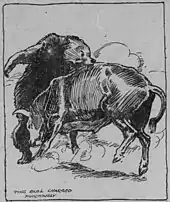
In the late 1700s, Spanish ranchers placed a poisoned "bait ball" made of suet or swine entrails filled with a lethal dose of strychnine which they hung from the branches of a tree within reach of the bear but out of reach of dogs and children.[9][17]: 21 Mexican settlers captured bears for bear and bull fights and they also sold their skins for 6 to 10 pesos to trading ships. Bear Trap Canyon near Bixby Creek was one of their favorite sites for trapping grizzly bears along the central California coast.[18][19] These bears were even turned into furniture, such as a chair gifted to President Andrew Jackson in 1865.[20]
Bear-baiting events flourished as popular spectacles in 19th century California.[21] Bloody fights that pitted bears against bulls[6] often inspired betting as to whether the bear or the bull would win. One persistently popular, but false[22] phrase origin story related to these fights stems from famous 19th-century newspaperman Horace Greeley. While visiting California Greeley allegedly witnessed such a fight, and supposedly gave the modern stock market its "bear" and "bull" nicknames based on the fighting styles of the two animals: the bear swipes downward while the bull hooks upward. In truth, the phrase's origins predate Greeley's 1859 journey to California by at least 100 years,[23] but the myth of the California connection persists.
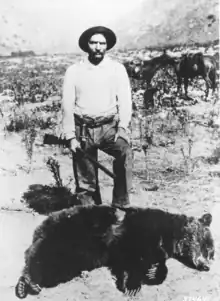
The Monterey County Herald noted on July 4, 1874:
Last Monday, Captain A. Smith, who resides about ten miles from town, in the Carmel Valley, succeeded in poisoning a large grizzly bear. Bruin had been annoying the neighborhood by destroying cattle, etc., for several years past, and all efforts to exterminate him seem futile. In some manner, however, he was induced partake of that "cold pizen" the captain had prepared for his special benefit. He is not likely to repeat his experiment.[9]
European settlers paid bounties on the bears who regularly preyed on livestock until the early 20th century.[24][25]: 4 Absolom (Rocky) Beasley hunted grizzly bears throughout the Santa Lucia Mountains and claimed to have killed 139 bears in his lifetime.[26] Noted California mountain man Seth Kinman claimed to have shot over 800 grizzly bears in a 20 year period in the areas surrounding present day Humboldt County. One prospector in Southern California, William F. Holcomb (nicknamed "Grizzly Bill" Holcomb), was particularly well known for hunting grizzly bears in what is now San Bernardino County. During September 1897, in the mountains between Inwood and Mt. Lassen, Shasta County, 21-year-old Elias Weigart and his dog encountered a huge California grizzly whose front track measured 11 inches and the rear, 19. The bear died after Weigart emptied his Winchester 38-55 into the beast at close range.[27]
The last hunted California grizzly bear was shot in Tulare County, California, in August 1922, although no body, skeleton or pelt was ever produced. Less than 75 years after the discovery of gold in 1848, almost every grizzly bear in California had been tracked down and killed. In 1924, what was thought to be a grizzly was spotted in Sequoia National Park for the last time and thereafter, grizzlies were never seen again in California.[12][28][29][30]
Reintroduction
Efforts to reintroduce grizzlies to the state are growing in number.[31] California still has habitat that can sustain about 500 grizzlies.[32] In 2014, the U.S. Fish and Wildlife Service received and rejected a petition to reintroduce grizzly bears to California.[33][34] In 2015, the Center for Biological Diversity launched a petition aimed at the California state legislature to reintroduce the grizzly bear to the state.[35][36][37]
In anticipation of the 2024 centennial marking the final recorded sighting of a wild grizzly bear in California, a collaborative effort was initiated by scientists affiliated with the Research Network, prominent leaders from California Tribes, and advocates associated with conservation nonprofits. This initiative resulted in the establishment of the California Grizzly Alliance.[38]
Despite these efforts, however, their reintroduction remains controversial. Arguments against grizzly bear reintroduction emphasize the potential for rare but significant harm, such as injuries or fatalities. Those who deem any harm, especially loss of human life, morally unacceptable view the reintroduction in California as an intolerable threat, regardless of individual risk.[31]
Symbolism
The California grizzly bear is one of the state's most visible and enduring symbols, adorning both the state flag and seal. The Bear Flag first flew in 1846 as a symbol of the short-lived California Republic. A second version was adopted as the state flag by the state legislature in 1911.[39] The bear symbol became a permanent part of the state seal in 1849. The California grizzly bear was designated the official state animal in 1953.[40][41] The bear is celebrated in name and as mascot of the sports teams of the University of California, Berkeley (the California Golden Bears), and of the University of California, Los Angeles (the UCLA Bruins) and in the mascot of University of California, Riverside (the UC Riverside Highlanders). The California Maritime Academy operates a training ship named Golden Bear.
References
- IUCN (2016-02-02). "Ursus arctos: McLellan, B.N., Proctor, M.F., Huber, D. & Michel, S.: The IUCN Red List of Threatened Species 2017: e.T41688A121229971". doi:10.2305/iucn.uk.2017-3.rlts.t41688a121229971.en. Retrieved 2023-10-07.
- "Ursus arctos. NatureServe Explorer 2.0". explorer.natureserve.org. Retrieved 14 September 2023.
- Wright, William Henry (1909), The Grizzly Bear: The Narrative of a Hunter-naturalist, Historical, Scientific and Adventurous
- Grisly indeed, Grizzly Island was aptly named". Daily Republic. Retrieved 5 May 2011.
- Miller, C.; Waits, L.; Joyce, P. (2006). "Phylogeography and mitochondrial diversity of extirpated brown bear (Ursus arctos) populations in the contiguous United States and Mexico". Mol Ecol. 15 (14): 4477–4485. doi:10.1111/j.1365-294X.2006.03097.x. PMID 17107477. S2CID 7336900.
- Storer, T.I.; Tevis, L.P. (1996). California Grizzly. Berkeley, CA: University of California Press. pp. 335, 42–187. ISBN 978-0-520-20520-8. Archived from the original on 2012-09-07.
- Rausch, Robert L. (July 1953). "On the Status of some Arctic Mammals". Journal of the Arctic Institute of North America. Faculty Publications from the Harold W. Manter Laboratory of Parasitology. Paper 497. 6 (2).
- Stephens, Tim (14 March 2013), DNA Study Clarifies Relationship Between Polar Bears and Brown Bears, Newscenter: University Of California, Santa Cruz
- Miller, Adam (14 January 2021). "The Folklore of Big Sur | Adam Miller - Folksinger and Storyteller". Archived from the original on 17 February 2022. Retrieved 17 February 2022.
- "Journal of Sierra Nevada History & Biography". www.sierracollege.edu. Archived from the original on 2021-11-13. Retrieved 2021-11-13.
- "Animal – California Grizzly Bear | California State Capitol Museum". Retrieved 2023-10-17.
- "Valley Center History Museum". Retrieved 2018-10-16.
- "California grizzly bear (extinct)". Retrieved 2018-10-16.
- "Los Altos: The Historical Context" (PDF). The City of Los Altos. April 2011. p. II-1.
- Storer, Tracy; Tevis, Lloyd (1996). California Grizzly. Berkeley, California: University of California Press. p. 14. ISBN 9780520205208.
- Storer, Tracy; Tevis, Lloyd (1996). California Grizzly. Berkeley, CA: University of California Press. p. 23. ISBN 9780520205208.
- Cross, Robert (2010). Big Sur Tales. Bloomington, IN. ISBN 978-1456711498.
{{cite book}}: CS1 maint: location missing publisher (link) - Williams, Honey Redwood Sanctuary Mid -Coast Investments
- "Stories | California History - Juan becomes a Rancher". thisweekincaliforniahistory.com. 4 September 2013. Retrieved 16 March 2018.
- The Grizzly-Bear Chair Presented, Sept. 8, 1865, to Andrew Johnson, President U.S., by Seth Kinman, the California Hunter and Trapper. Washington, D.C: M.B. Brady & Co., 1865. Print.
- "The Brutal Bull-and-Bear Fights of 19th-Century California". 23 October 2017. Retrieved 2018-10-16.
- "Bull, n1 III.8.a." OED Online. Oxford University Press, December 2014. Web. 20 January 2015.
- "The History of 'Bull' and 'Bear' Markets". Retrieved 2018-10-16.
- Woolfenden, John (1981). Big Sur: A Battle for the Wilderness 1869–1981. Pacific Grove, California: The Boxwood Press. p. 72.
- Thornton, Stuart (February 2001). "A Dirty Journey to the Lost City of the Santa Lucias".
- "DCQ Summer Solstice 1999 -- Times Past". www.ventanawild.org. Archived from the original on 2009-06-12.
- "Last Grizzly in Shasta". Field and Stream. Recurrent Ventures. 31 August 2022. Retrieved 4 September 2022.
- Johnson, Brett (August 9, 2014). "Great grizzly bear hunt in Santa Paula backcountry reaps state flag icon, tall tales". Ventura County Star. Retrieved 5 May 2016.
- Grinnell, J.; Dixon, J.; Linsdale., J. (1937). Fur bearing animals of California.
- Orona, Ajay (2023-03-27). "A Grizzly Bear Comeback?". Alta Online. Retrieved 2023-10-17.
- A., Lee; Laird, A.M.; Brann, L.; Coxon, C.; Hamilton, A.J.; Lawhon, L.A.; Martin, J.A.; Rehnberg, N.; Tyrrell, B.P.; Welch, Z.; Hale, B.; Alagona, P.S. (2021). "The Ethics of Reintroducing Large Carnivores: The Case of the California Grizzly". Conservation & Society. 19 (1): 80–90. ISSN 0972-4923.
- Carroll, C.; R. F. Noss; N. H. Schumaker; P. C. Paquet (2001). David Maehr; Reed F. Noss; Jeffery L. Larkin (eds.). Large Mammal Restoration: Ecological and Sociological Challenges in the 21st Century (1 ed.). Washington, D.C.: Island Press. pp. 25–46. ISBN 978-1-5596-3817-3.
Is the return of the wolf, wolverine, and grizzly bear to Oregon and California biologically feasible?
- Woody, Todd (20 Jun 2014). "A New Move to Bring the Grizzly Bear Back to California". TakePart. Participant Media. Archived from the original on 2 December 2019. Retrieved 10 November 2015.
- "EDITORIAL: Grizzly bear homecoming?". Fresno Bee. 19 Jul 2014. Retrieved 28 Sep 2015.
- "Where are the Bears?". Center for Biological Diversity. Archived from the original on March 10, 2016. Retrieved February 28, 2016.
- Platt, John (28 Jul 2015). "Waving the Flag for the Grizzly's Return to California". TakePart. Participant Media. Archived from the original on 2 December 2019. Retrieved February 28, 2016.
- Miller, Craig (May 2, 2016). "Move to Return Grizzly Bears to California Will Be an Uphill Push". KQED Science. Retrieved 5 May 2016.
- "Bring Back the Bears". www.biologicaldiversity.org. Retrieved 2023-10-24.
- Trinkle, William J. (4 August 2013). "A Brief History of the Bear Flag". The Bear Flag Museum. Sacramento, CA USA. Retrieved 7 May 2014.
The flag soon came to be called the "Bear Flag" and the insurgency came to be called the "Bear Flag Revolt"
- "History and Culture – State Symbols". California State Library. Archived from the original on 5 January 2019. Retrieved 23 September 2011.
- California State Legislature (1911), "An act to select adopt the bear flag as the state flag of California", The statutes of California and amendments to the codes passed at the thirty-ninth session of the legislature, San Francisco: Bancroft-Whitney, p. 6, retrieved 24 September 2011
Further reading
- Brown, David E. (1996). The Grizzly in the Southwest: Documentary of an Extinction. University of Oklahoma Press. ISBN 978-0-8061-2880-1.
- Merriam, C. Hart (13 April 1896), "Preliminary Synopsis of the American Bears", Proceedings of the Biological Society of Washington, 10: 65–83 + plates IV–VI, retrieved 23 September 2011
- Wozencraft, W. C. (2005). "Subspecies Ursus arctos californicus". In Wilson, D. E.; Reeder, D. M. (eds.). Mammal Species of the World: A Taxonomic and Geographic Reference (3rd ed.). Johns Hopkins University Press. p. 589. ISBN 978-0-8018-8221-0. OCLC 62265494.
- Merriam, C. Hart (13 August 1914), "Description of Thirty apparently New Grizzly and Brown Bears from North America", Proceedings of the Biological Society of Washington, 27: 173–196, retrieved 24 September 2011
- Merriam, C. Hart (6 September 1916), "Nineteen Apparently New Grizzly and Brown Bears from Western America", Proceedings of the Biological Society of Washington, 29: 133–154, retrieved 24 September 2011
- Hall, E. Raymond (10 August 1984), "Geographic variation among brown and grizzly bears (Ursus arctos) in North America", Special publication 13, University of Kansas Museum of Natural History, retrieved 24 September 2011
- Miller, Craig R.; Waits, Lisette P.; Joyce, Paul (December 2006), "Phylogeography and mitochondrial diversity of extirpated brown bear (Ursus arctos) populations in the contiguous United States and Mexico" (PDF), Molecular Ecology, 15 (14): 4477–4485, doi:10.1111/j.1365-294X.2006.03097.x, PMID 17107477, S2CID 7336900, archived from the original (PDF) on 24 March 2012, retrieved 24 September 2011
- Solnit, Rebecca; Caron, Mona (2010), A California Bestiary, Berkeley, CA: Heyday Books, pp. 13–15, ISBN 978-1-59714-125-3
External links
- "Ursus arctos californicus". Integrated Taxonomic Information System.
- "Ursus arctos californicus Merriam, 1896" at the Encyclopedia of Life
![]() Data related to Ursus arctos californicus at Wikispecies
Data related to Ursus arctos californicus at Wikispecies

